oil additives CHEVROLET KODIAK 2009 Owners Manual
[x] Cancel search | Manufacturer: CHEVROLET, Model Year: 2009, Model line: KODIAK, Model: CHEVROLET KODIAK 2009Pages: 376, PDF Size: 5.39 MB
Page 203 of 376
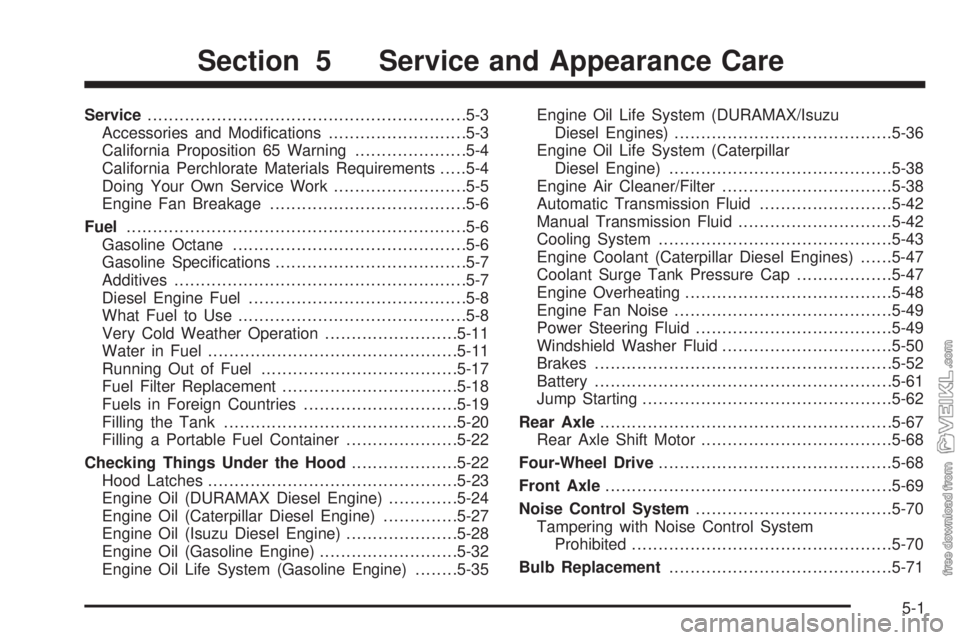
Service............................................................5-3
Accessories and Modifications..........................5-3
California Proposition 65 Warning.....................5-4
California Perchlorate Materials Requirements.....5-4
Doing Your Own Service Work.........................5-5
Engine Fan Breakage.....................................5-6
Fuel................................................................5-6
Gasoline Octane............................................5-6
Gasoline Specifications....................................5-7
Additives.......................................................5-7
Diesel Engine Fuel.........................................5-8
What Fuel to Use...........................................5-8
Very Cold Weather Operation.........................5-11
Water in Fuel...............................................5-11
Running Out of Fuel.....................................5-17
Fuel Filter Replacement.................................5-18
Fuels in Foreign Countries.............................5-19
Filling the Tank............................................5-20
Filling a Portable Fuel Container.....................5-22
Checking Things Under the Hood....................5-22
Hood Latches...............................................5-23
Engine Oil (DURAMAX Diesel Engine).............5-24
Engine Oil (Caterpillar Diesel Engine)..............5-27
Engine Oil (Isuzu Diesel Engine).....................5-28
Engine Oil (Gasoline Engine)..........................5-32
Engine Oil Life System (Gasoline Engine)........5-35Engine Oil Life System (DURAMAX/Isuzu
Diesel Engines).........................................5-36
Engine Oil Life System (Caterpillar
Diesel Engine)..........................................5-38
Engine Air Cleaner/Filter................................5-38
Automatic Transmission Fluid.........................5-42
Manual Transmission Fluid.............................5-42
Cooling System............................................5-43
Engine Coolant (Caterpillar Diesel Engines)......5-47
Coolant Surge Tank Pressure Cap..................5-47
Engine Overheating.......................................5-48
Engine Fan Noise.........................................5-49
Power Steering Fluid.....................................5-49
Windshield Washer Fluid................................5-50
Brakes........................................................5-52
Battery........................................................5-61
Jump Starting...............................................5-62
Rear Axle.......................................................5-67
Rear Axle Shift Motor....................................5-68
Four-Wheel Drive............................................5-68
Front Axle......................................................5-69
Noise Control System.....................................5-70
Tampering with Noise Control System
Prohibited.................................................5-70
Bulb Replacement..........................................5-71
Section 5 Service and Appearance Care
5-1
Page 209 of 376
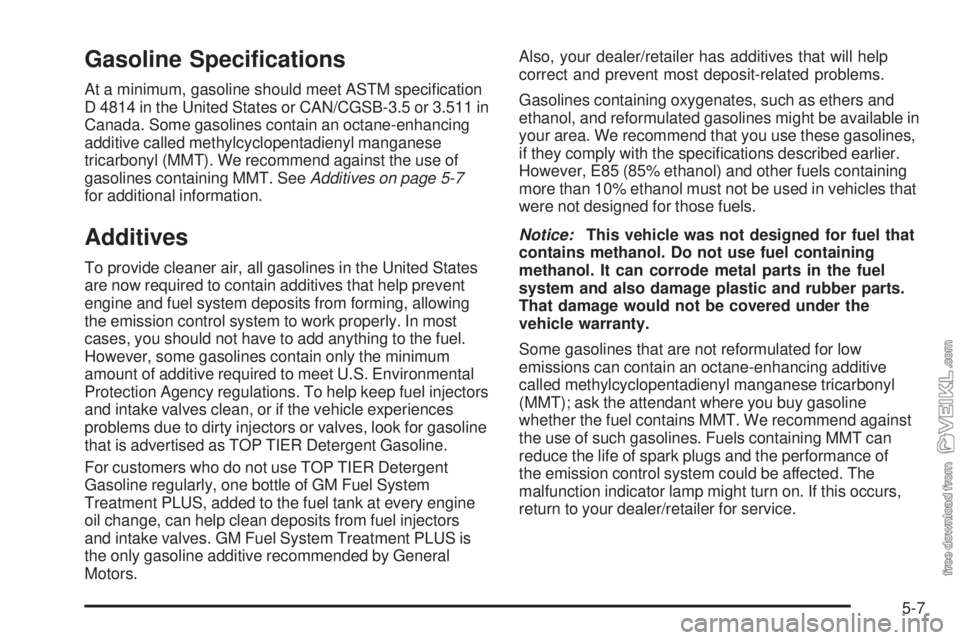
Gasoline Specifications
At a minimum, gasoline should meet ASTM specification
D 4814 in the United States or CAN/CGSB-3.5 or 3.511 in
Canada. Some gasolines contain an octane-enhancing
additive called methylcyclopentadienyl manganese
tricarbonyl (MMT). We recommend against the use of
gasolines containing MMT. SeeAdditives on page 5-7
for additional information.
Additives
To provide cleaner air, all gasolines in the United States
are now required to contain additives that help prevent
engine and fuel system deposits from forming, allowing
the emission control system to work properly. In most
cases, you should not have to add anything to the fuel.
However, some gasolines contain only the minimum
amount of additive required to meet U.S. Environmental
Protection Agency regulations. To help keep fuel injectors
and intake valves clean, or if the vehicle experiences
problems due to dirty injectors or valves, look for gasoline
that is advertised as TOP TIER Detergent Gasoline.
For customers who do not use TOP TIER Detergent
Gasoline regularly, one bottle of GM Fuel System
Treatment PLUS, added to the fuel tank at every engine
oil change, can help clean deposits from fuel injectors
and intake valves. GM Fuel System Treatment PLUS is
the only gasoline additive recommended by General
Motors.Also, your dealer/retailer has additives that will help
correct and prevent most deposit-related problems.
Gasolines containing oxygenates, such as ethers and
ethanol, and reformulated gasolines might be available in
your area. We recommend that you use these gasolines,
if they comply with the specifications described earlier.
However, E85 (85% ethanol) and other fuels containing
more than 10% ethanol must not be used in vehicles that
were not designed for those fuels.
Notice:This vehicle was not designed for fuel that
contains methanol. Do not use fuel containing
methanol. It can corrode metal parts in the fuel
system and also damage plastic and rubber parts.
That damage would not be covered under the
vehicle warranty.
Some gasolines that are not reformulated for low
emissions can contain an octane-enhancing additive
called methylcyclopentadienyl manganese tricarbonyl
(MMT); ask the attendant where you buy gasoline
whether the fuel contains MMT. We recommend against
the use of such gasolines. Fuels containing MMT can
reduce the life of spark plugs and the performance of
the emission control system could be affected. The
malfunction indicator lamp might turn on. If this occurs,
return to your dealer/retailer for service.
5-7
Page 210 of 376
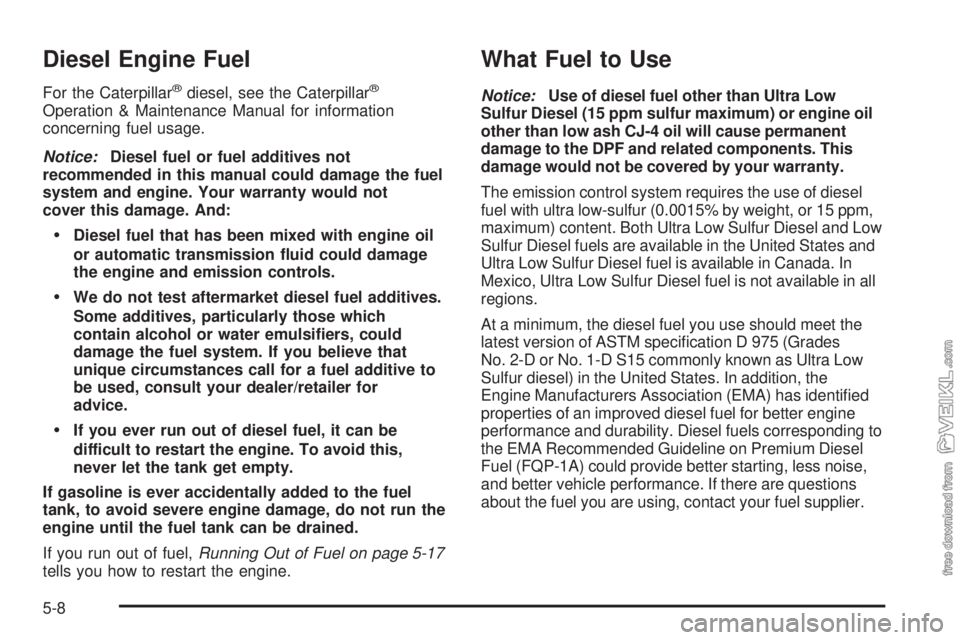
Diesel Engine Fuel
For the Caterpillar®diesel, see the Caterpillar®
Operation & Maintenance Manual for information
concerning fuel usage.
Notice:Diesel fuel or fuel additives not
recommended in this manual could damage the fuel
system and engine. Your warranty would not
cover this damage. And:
•Diesel fuel that has been mixed with engine oil
or automatic transmission fluid could damage
the engine and emission controls.
•We do not test aftermarket diesel fuel additives.
Some additives, particularly those which
contain alcohol or water emulsifiers, could
damage the fuel system. If you believe that
unique circumstances call for a fuel additive to
be used, consult your dealer/retailer for
advice.
•If you ever run out of diesel fuel, it can be
difficult to restart the engine. To avoid this,
never let the tank get empty.
If gasoline is ever accidentally added to the fuel
tank, to avoid severe engine damage, do not run the
engine until the fuel tank can be drained.
If you run out of fuel,Running Out of Fuel on page 5-17
tells you how to restart the engine.
What Fuel to Use
Notice:Use of diesel fuel other than Ultra Low
Sulfur Diesel (15 ppm sulfur maximum) or engine oil
other than low ash CJ-4 oil will cause permanent
damage to the DPF and related components. This
damage would not be covered by your warranty.
The emission control system requires the use of diesel
fuel with ultra low-sulfur (0.0015% by weight, or 15 ppm,
maximum) content. Both Ultra Low Sulfur Diesel and Low
Sulfur Diesel fuels are available in the United States and
Ultra Low Sulfur Diesel fuel is available in Canada. In
Mexico, Ultra Low Sulfur Diesel fuel is not available in all
regions.
At a minimum, the diesel fuel you use should meet the
latest version of ASTM specification D 975 (Grades
No. 2-D or No. 1-D S15 commonly known as Ultra Low
Sulfur diesel) in the United States. In addition, the
Engine Manufacturers Association (EMA) has identified
properties of an improved diesel fuel for better engine
performance and durability. Diesel fuels corresponding to
the EMA Recommended Guideline on Premium Diesel
Fuel (FQP-1A) could provide better starting, less noise,
and better vehicle performance. If there are questions
about the fuel you are using, contact your fuel supplier.
5-8
Page 229 of 376
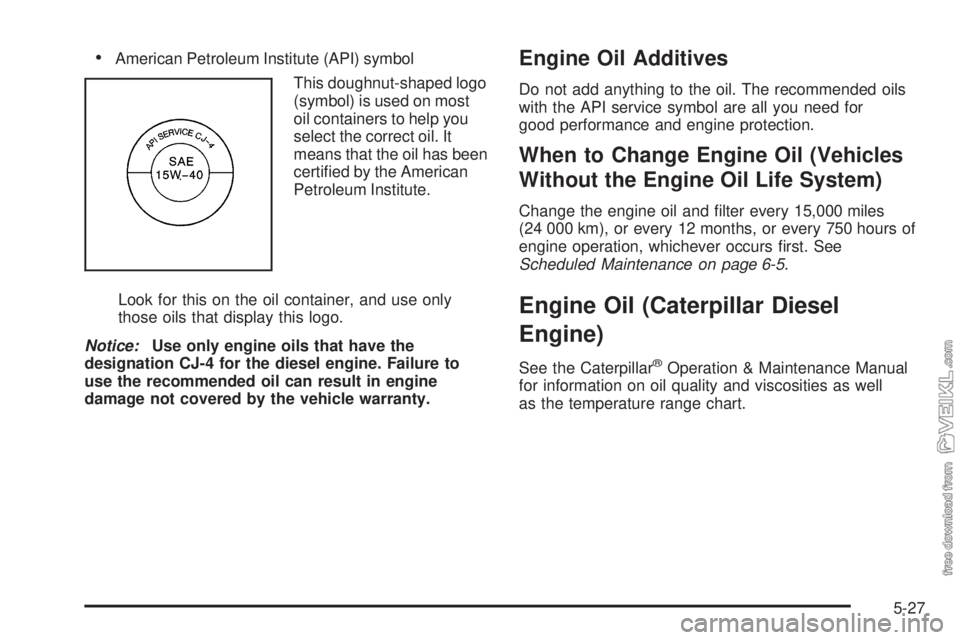
•American Petroleum Institute (API) symbol
This doughnut-shaped logo
(symbol) is used on most
oil containers to help you
select the correct oil. It
means that the oil has been
certified by the American
Petroleum Institute.
Look for this on the oil container, and use only
those oils that display this logo.
Notice:Use only engine oils that have the
designation CJ-4 for the diesel engine. Failure to
use the recommended oil can result in engine
damage not covered by the vehicle warranty.Engine Oil Additives
Do not add anything to the oil. The recommended oils
with the API service symbol are all you need for
good performance and engine protection.
When to Change Engine Oil (Vehicles
Without the Engine Oil Life System)
Change the engine oil and filter every 15,000 miles
(24 000 km), or every 12 months, or every 750 hours of
engine operation, whichever occurs first. See
Scheduled Maintenance on page 6-5.
Engine Oil (Caterpillar Diesel
Engine)
See the Caterpillar®Operation & Maintenance Manual
for information on oil quality and viscosities as well
as the temperature range chart.
5-27
Page 233 of 376
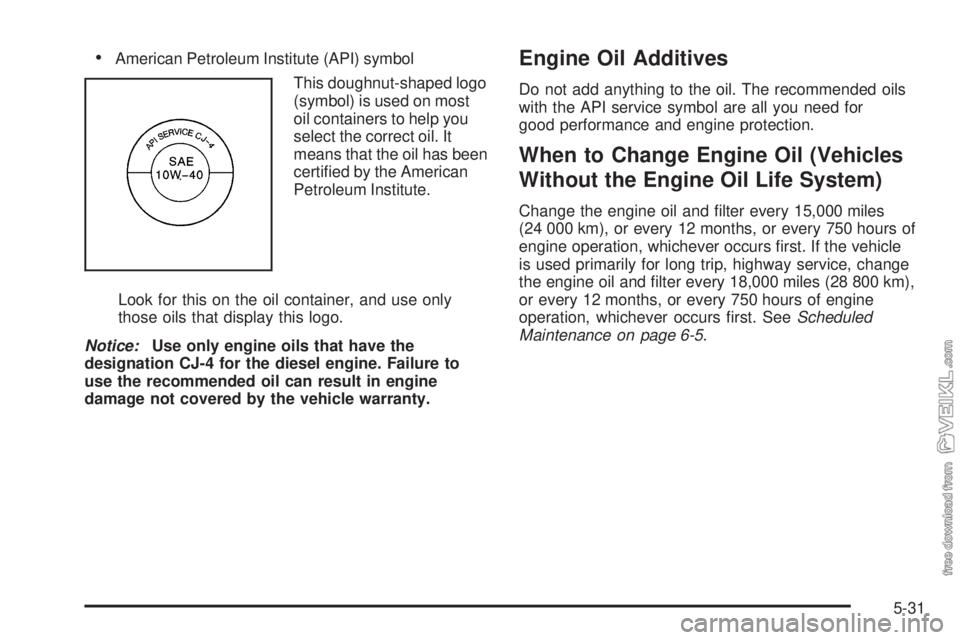
•American Petroleum Institute (API) symbol
This doughnut-shaped logo
(symbol) is used on most
oil containers to help you
select the correct oil. It
means that the oil has been
certified by the American
Petroleum Institute.
Look for this on the oil container, and use only
those oils that display this logo.
Notice:Use only engine oils that have the
designation CJ-4 for the diesel engine. Failure to
use the recommended oil can result in engine
damage not covered by the vehicle warranty.Engine Oil Additives
Do not add anything to the oil. The recommended oils
with the API service symbol are all you need for
good performance and engine protection.
When to Change Engine Oil (Vehicles
Without the Engine Oil Life System)
Change the engine oil and filter every 15,000 miles
(24 000 km), or every 12 months, or every 750 hours of
engine operation, whichever occurs first. If the vehicle
is used primarily for long trip, highway service, change
the engine oil and filter every 18,000 miles (28 800 km),
or every 12 months, or every 750 hours of engine
operation, whichever occurs first. SeeScheduled
Maintenance on page 6-5.
5-31
Page 237 of 376
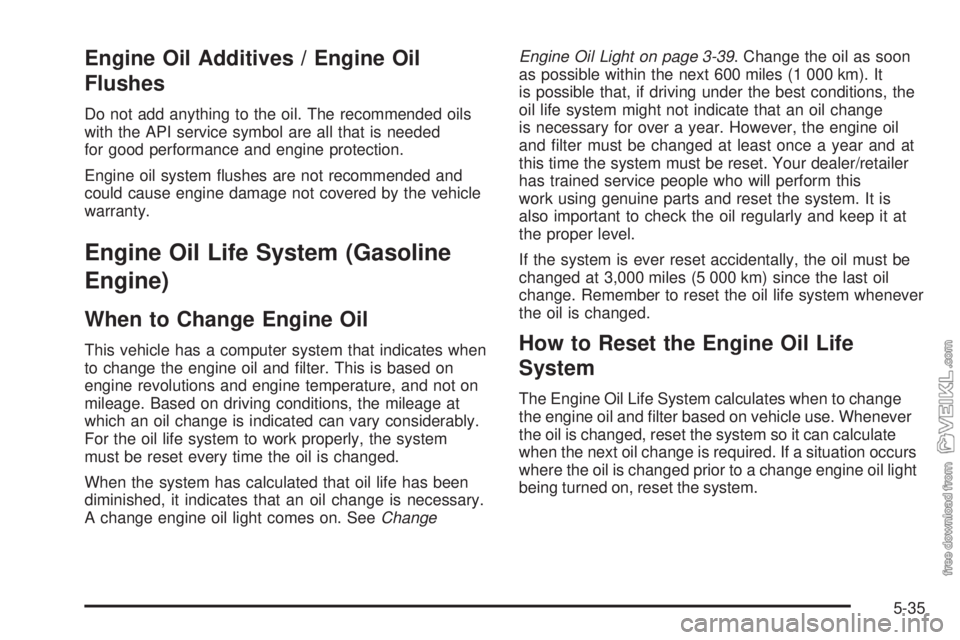
Engine Oil Additives / Engine Oil
Flushes
Do not add anything to the oil. The recommended oils
with the API service symbol are all that is needed
for good performance and engine protection.
Engine oil system flushes are not recommended and
could cause engine damage not covered by the vehicle
warranty.
Engine Oil Life System (Gasoline
Engine)
When to Change Engine Oil
This vehicle has a computer system that indicates when
to change the engine oil and filter. This is based on
engine revolutions and engine temperature, and not on
mileage. Based on driving conditions, the mileage at
which an oil change is indicated can vary considerably.
For the oil life system to work properly, the system
must be reset every time the oil is changed.
When the system has calculated that oil life has been
diminished, it indicates that an oil change is necessary.
A change engine oil light comes on. SeeChangeEngine Oil Light on page 3-39. Change the oil as soon
as possible within the next 600 miles (1 000 km). It
is possible that, if driving under the best conditions, the
oil life system might not indicate that an oil change
is necessary for over a year. However, the engine oil
and filter must be changed at least once a year and at
this time the system must be reset. Your dealer/retailer
has trained service people who will perform this
work using genuine parts and reset the system. It is
also important to check the oil regularly and keep it at
the proper level.
If the system is ever reset accidentally, the oil must be
changed at 3,000 miles (5 000 km) since the last oil
change. Remember to reset the oil life system whenever
the oil is changed.How to Reset the Engine Oil Life
System
The Engine Oil Life System calculates when to change
the engine oil and filter based on vehicle use. Whenever
the oil is changed, reset the system so it can calculate
when the next oil change is required. If a situation occurs
where the oil is changed prior to a change engine oil light
being turned on, reset the system.
5-35
Page 369 of 376

Engine (cont.)
Overheating................................................5-48
Overspeed Warning Light..............................3-40
Reduced Power Light...................................3-42
Shutdown Warning Light...............................3-40
Speed Limiter.............................................3-25
Starter Over-Crank Protection........................2-12
Starting Diesel............................................2-14
Starting the Gasoline...................................2-12
Entry Lighting.................................................3-17
Event Data Recorders.....................................7-12
Exhaust Brake Indicator Light...........................3-41
Exhaust Restrictor...........................................2-22
Extender, Safety Belt.......................................1-28
Exterior Lamps...............................................3-14
F
Filter
Engine Air Cleaner......................................5-38
Filter Minder Gage..........................................3-46
Finish Damage...............................................5-93
Fixed Mast Antenna........................................3-58
Flashers, Hazard Warning.................................. 3-6
Flat Tire........................................................5-85
Fluid
Automatic Transmission................................5-42
Power Steering...........................................5-49
Windshield Washer......................................5-50
Four-Wheel Drive....................................2-30, 5-68Front Axle......................................................5-69
Front Wheel Bearings with
Oil-Filled Hubs............................................5-75
Fuel............................................................... 5-6
Additives...................................................... 5-7
Change Filter Warning Light..........................3-45
Diesel Engine Fuel........................................ 5-8
Driving for Better Economy............................. 4-2
Filling a Portable Fuel Container....................5-22
Filling the Tank...........................................5-20
Filter..........................................................5-72
Filter Replacement.......................................5-18
Fuels in Foreign Countries............................5-19
Gage .........................................................3-44
Gasoline Octane........................................... 5-6
Gasoline Specifications.................................. 5-7
Primary Filter and Water Separator................5-73
Running Out of Fuel....................................5-17
Secondary Filter and Water
Separator/Heater......................................5-74
Very Cold Weather Operation........................5-11
Water in Fuel..............................................5-11
Water in Warning Light.................................3-45
What Fuel to Use.......................................... 5-8
Fuses
Fuses and Circuit Breakers...........................5-96
Instrument Panel Fuse Block.........................5-96
Underhood Fuse Block.................................5-99
Windshield Wiper.........................................5-95
5